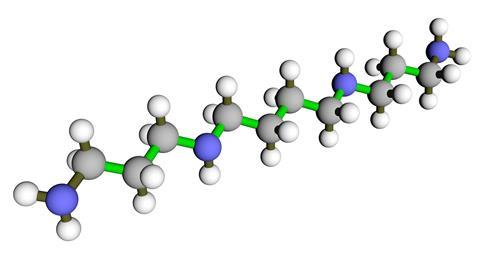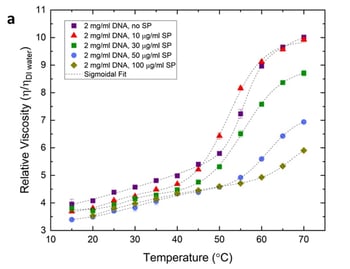As we have mentioned in previous blogs, deoxyribonucleic acid (DNA) is a charged polymer composed of two single strands that coil around each other to form a double helix or duplex that stores biological information and carries the genetic information of living systems for the development, maintenance, growth, and reproduction of organisms. DNA molecules can undergo an orderly packed (condensed) structure via condensation process that is crucial for a variety of biological applications such as gene therapy and gene regulation processes in living organisms. One interesting application of DNA condensation is in cystic fibrosis (CF) disease. Condensing agents can serve to reduce the viscosity of CF sputum in the lungs and facilitate its clearance from the lungs and airways.
DNA condensation is a phase transition that can be induced by condensing agents such as spermine and poly-L-lysine. Spermine is a tetravalent polyamine that binds to the double helix DNA, functioning as an effective condensing agent that neutralizes DNA charges and brings double helices together which leads to the formation of toroidal structures. Condensing agents can change the rheological properties and reduce the viscosity of DNA due to the structural changes and a reduction in the effective volume of the DNA molecules.
 Figure 2: Spermine 3D structure
Figure 2: Spermine 3D structure
Viscosity measurements can be used to characterize the melting temperature of DNA in the presence of condensing agent during a heating temperature sweep experiment which is important for applications that involve the denaturation of DNA in molecular biology techniques.
In an internal study, we examined the viscosity of 2 and 6 mg/ml DNA solutions in the presence of different concentrations of spermine where no visible precipitate was formed. The addition of spermine to the DNA solutions leads to the formation of toroidal structures with a typical diameter of 100 nm to 300 nm. DNA condensation and particularly toroidal structures have attracted attention in biological processes where it should be compacted to fit into the cells (e.g., sperm cells). It’s been reported that the morphology of DNA found in viruses is similar to the toroidal structure.  Figure 3: Relative viscosity versus temperature for 2 mg/mL CT-DNA sample in the presence of different concentrations of spermine
Figure 3: Relative viscosity versus temperature for 2 mg/mL CT-DNA sample in the presence of different concentrations of spermine
In our application note, Effect of Condensing Agent on the Viscosity and Melting Temperature of CT-DNA Solutions, we show how we use VROC® initium one plus to probe temperature-dependent viscosity of CT-DNA in the presence of different concentrations of spermine. Using the viscosity measurements, we are able to characterize the effect of condensing agent on the viscosity and melting temperature of DNA samples in a temperature sweep measurement.
Contact us to learn more about the importance of viscosity measurements in characterization of DNA or to learn how our VROC technology and how it can elevate your DNA studies and measurements.
Written by: Sohelia Shabaniverki, RheoSense Applications Scientist


